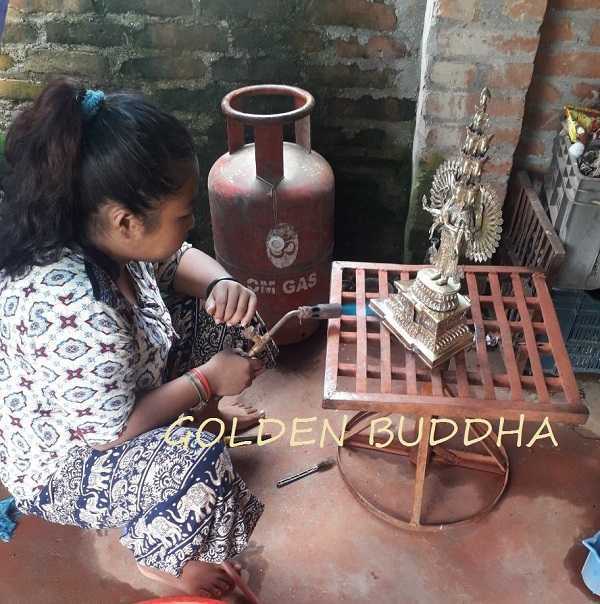Buddha Statue Buyer’s Guide
This is the comprehensive Buddha statue buyer’s guide with the best answers to all the most important questions concerning how to buy a Buddha statue. Indeed, buying a Buddha statue is an important decision that needs to be thoroughly researched. Please refer to the list of questions below which link to each answer. At first glance, it may appear quite overwhelming, but rest assured it will be well worth your time.
Are Decorative Buddha statues offensive?
What is the Meaning of a Buddha statue?
Do Buddha Statues Have Rules Of Etiquette?
What Direction Should a Buddha Statue Face?
What is the Identity of the Buddha Statue?
Do Some Buddha Statues Compliment Each Other?
Where Do You Buy a Buddha Statue?
Why Do I Need A Buddha Statue?
Why Are Some Buddha Statues Fat?
Why is a man and woman in sexual union?
Why are there so many statues of Buddha?
May I receive a Buddha Statue as a gift?
Did I buy the right Buddha statue?
Why do people pray to Buddha statues?
What goes on my Buddhist altar?
Why are Buddha statues standing?
Are your statues gilded with pure gold?
Did I buy a fake gold Buddha statue?
What did Buddha really look like?
Why are Buddha statues lying down?
Why is the Buddha’s head pointed?
Why are the Buddha’s ears so big?
What is the oval on the Buddha’s forehead?
Why are Buddha statues holding a bowl?
Can your Buddha statues be filled with mantras?
Do you cover the face of the Buddha statue?
Do you have filling and consecration services?
Are your Nepali items certified?
Are your statues fire gilded or electroplated?
Are Decorative Buddha Statues Offensive?
No, there is nothing offensive about Buddha statues or ritual items created from precious metals. In fact, our Nepali statues and Tibetan ritual items use the same designs and sculpting techniques that have supplied the Tibetan monasteries for many centuries. The use of 24k gold gilding immunizes the statue from tarnish and indefinitely preserves its beauty. Additionally, purchasing a valuable Buddha statue shows sacrifice and dedication which will help you to gain merit. If someone finds a valuable Buddha statue offensive, they are probably just jealous.
What is the Meaning of a Buddha statue?
The most important aspect to consider before purchasing your Buddha statue is the meaning. Fortunately, the meaning of the Buddha statue is revealed by the Buddha statues’ mudras and postures. These are the hand gestures that you see each of the different statues displaying. As a result of the mudras we can identify which Buddhist deity the statue represents and also the Buddha statue meaning. Additionally, the mudras teach devotees about different events that occurred during the life of the historical Buddha.
Do Buddha Statues Have Rules Of Etiquette?
- Please do not place the Buddha statue in the bedroom, kitchen or bathroom.
- Always place the Buddha statue so it sits at least 2.5 feet off of the floor.
- The Buddha statue should be placed in good light where it can be seen and appreciated.
- If possible, always situate the Buddha statue so it is facing the front door of your house from the inside. As a result, it will attract positive energy as you enter and deflect negative energy back out the door.
- Acquire your Buddha statue in a positive spirit and with confidence.
- Click here to learn more about the creation of qi energy in your home by using Buddha statues and Tibetan ritual items.
What Direction Should a Buddha Statue Face?
It is most beneficial to have the Buddha statue facing the front door of your home from the inside. As a result, it is the first thing you see as you enter the house. The Buddha will encourage you to disregard all traces of bitterness before entering. This would also apply if the Buddha statue is in a hallway or meditation room. It should be the first thing you see when you enter.
Some buyers are specifically interested in auspicious directions. If so, I would suggest you consult with a feng shui expert. But for general purposes, the entrances to the most venerable Buddhist and Hindu temples face East (sunrise). One major exception is Angkor Wat in Cambodia. Angkor Wat faces West for reasons that still perplex archeologists.
Furthermore, some Buddhas are guardians of the specific direction where their pure land is located. For example, Amitabha resides in the Western direction and his Pure Land of Sukhavati is located there. Akshobhya Buddha is the ruler of the Eastern paradise of Abhirati and Ratnasambhava Buddha resides in the South.
What is the Identity of the Buddha Statue?
Many Buddha statues have similar facial expressions which can conceal their true identity. Therefore, we must rely on the Buddha’s mudras and posture for identification. Some general identification rules are:
- Shakyamuni Buddha – “Earth Touching” or Bhumisparsha Mudra
- Protection Buddha – Shakyamuni Buddha using “Protection” or Abhaya Mudra
- Medicine Buddha – “Gift Giving” Varada Mudra, Medicine Bowl
- Amitabha Buddha – “Meditation” or Dhyana Mudra with Alms Bowl
- Aparmita Buddha -“Meditation” or Dhyana Mudra with “Vessel of Longevity”
- White Tara – “Gift Giving” Varada Mudra, 7 Eyes, 2 lotus flowers
- Green Tara – “Gift Giving” Varada Mudra, 2 Eyes, One Leg in Panhandle
- Chenrezig – 4 armed seated statue, Lotus flower grows over left shoulder
- Avalokitesvara – 1000 arms and 11 heads
- Manjushri – Raised sword in right hand, lotus flower grows over left shoulder
- Vajradhara – Diamond Mudra, holds vajra and bell, hands crossed in front of heart
- Vajrasattva – Vajra in right hand in front of heart and a bell in his left hand on his lap
Do Some Buddha Statues Compliment Each Other?
Yes, certain Buddha statues compliment each other. Indeed, Buddhist Temple altars commonly display several statues together. However, the combination of statues will vary depending on the geographic location of the temple. Here are a few commonly seen display options:
Five Dhyani Buddhas
In Tibetan Buddhism, a highly venerated combination of statues is the five Dhyani Buddhas. Each Buddha symbolizes the purification of a specific negative emotion and its transformation into a corresponding virtue. Additionally, each Dhyani Buddha is associated with their own color, direction, animal and mudra.
The Five Dhyani Buddhas are Vairocana, Amitabha, Ratnasambhava, Akshobhya and Amoghasiddhi. Additionally, each of the Five Dhyani Buddhas represents a specific time period in the life of the historical Buddha.
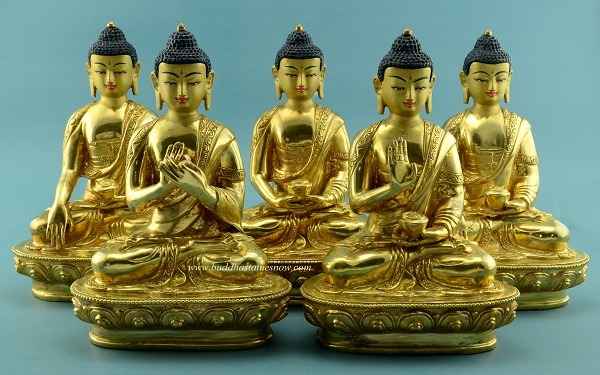
Medicine Buddha Trinity
In Mahayana Buddhism, there is a very influential Buddhist text called the Medicine Buddha Sutra. The sutra identifies Amitabha Buddha as the guardian of the west, Medicine Buddha is the guardian of the East and Shakyamuni Buddha represents the basic Buddha principle. As a result, these three Buddhas form an excellent combination.
This combination of statues places Shakyamuni Buddha in the middle (slightly elevated), Amitabha Buddha on his right and Medicine Buddha to the left. Symbolically, Shakyamuni Buddha is the basic Buddha principle. In addition, Amitabha Buddha offers devotees heavenly rebirth in Sukhavati and Medicine Buddha protects them during their worldly life.
Shakyamuni Buddha Trinity
Shakyamuni Buddha and two representational Bodhisattva statues can also make a meaningful combination. Manjushri represents the “Buddha’s wisdom” and Avalokitesvara represents the “Buddha’s compassion”. In this combination, Shakyamuni can be placed in back elevated on an altar with both of the Bodhisattvas in the foreground.
Where Do You Buy a Buddha Statue?
The best Buddha statues in the world are created in Kathmandu, Nepal. If possible, I recommend traveling there and buying your statue in person. If that is not possible, you can purchase authentic Nepali statues, thangkas and ritual items on this website with free international shipping. Use out Buddha statue buyer’s guide for reference purposes.
Why Do I Need A Buddha Statue?
Visual aids have been used as motivational tools for time immemorial. Buddha statues personify the virtuosity of the Buddhist deity which they embody. Indeed, a beautiful Buddha statue allows devotees to visualize virtue. This creates lifestyle changes that result in good karma and the accumulation of merit. This creates happiness in your life and it can even produce miracles.
Furthermore, Buddhists and non Buddhists alike will appreciate that a Buddha statue can be a strong factor in the creation of positive energy. In that sense, Buddha statues are also used for tasteful home or office decoration.
Why Are Some Buddha Statues Fat?
In Chinese Buddhism there exists a “Fat Buddha” who is also known as “Budai”. Indeed, Budai is extremely popular in China as a symbol of happiness and prosperity. However, he is also remembered in real life as a monk who lived in the 10th century.
The name Budai translates as “cloth sack” as he was always seen with a sack slung over his shoulder holding his few possessions. Budai is also commonly depicted with children which are symbols of wealth and prosperity in China. Additionally, Chinese Buddhists believe that he is an incarnation of the Future Buddha called Maitreya.
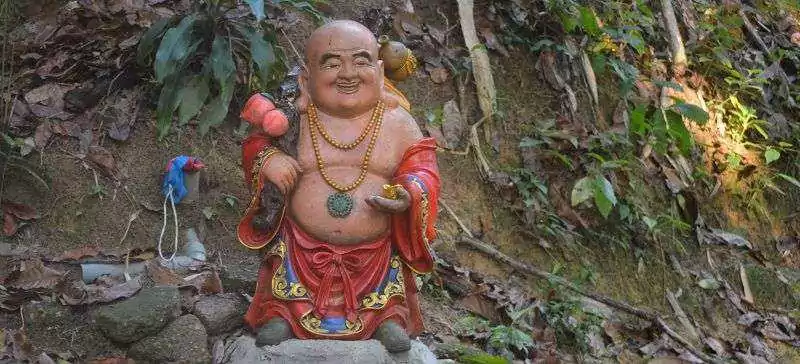
Why is a man and woman in sexual union?
This is known as “Shakti” or “Yab Yum”. It is a depiction of the primordial union of wisdom and compassion. The origins of this esoteric embrace are found in the Anuttarayoga Tantra of Vajrayana Buddhism.
As such, the male deity represents the attribute of compassion and the female deity represents the attribute of wisdom. They are depicted locked in sensual embrace with the male standing or seated and the female deity wrapped around him. Yab Yum statues can be depicted in peaceful or wrathful form.
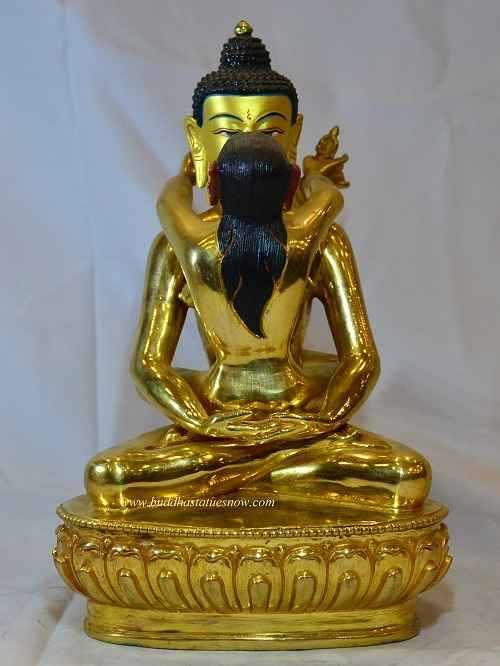
Why are there so many statues of Buddha?
Although there is only one original Buddha, there are many other Buddhas and Bodhisattvas. As a result, many “Buddha” statues are really not depictions of the Buddha. Instead they are a depiction of a different Buddhist deity altogether. The most common case of mistaken identity is “Happy Buddha” which is really a depiction of the Chinese deity “Budai”.
An additional issue that can create confusion is many Buddhas and Bodhisattvas are called by several different names depending on the Buddhist school or geographical region. For example, the historical Buddha is also known as Shakyamuni Buddha, Gautama Buddha or just “the Buddha”.
It is necessary to differentiate the mudras and postures displayed by the different statues. As a result, you will discover the true identity and Buddha statue meaning.
May I receive a Buddha Statue as a gift?
Yes, of course you may receive a Buddha statue as a gift. The only problem is that it can result in significant delays. Therefore, if you are inspired by a particular Buddha statue it is important that you do not delay your purchase. There is certainly no bad karma in buying your own statue! In fact, the self sacrifice in acquiring a valuable Buddha statue can be considered meritorious.
Did I buy the right Buddha statue?
In addition to the information contained in our Buddha statue buyer’s guide, the statues listings are clearly identified and described in great detail in the product descriptions. Additionally, I am always available to answer questions. If in doubt, please ask before you commit to the purchase.
Why do people pray to Buddha statues?
Buddhism does not require that devotees pray to Buddhist deities or even to the Buddha himself. Nonetheless, some devotees do pray to the statues and deities for inspiration and favor. This is similar to Christians praying to the Virgin Mary or the saints even though the Bible does not teach it – read more here.
What goes on my Buddhist altar?
Besides a Buddha statue(s), common additions to your Buddhist altar include flowers, incense, candles, fruit, a bowl of water and a lotus. Each offering carries special significance related to Buddhist virtues and beliefs.
- Incense – The smell of incense fills Buddhist shrines because the sweet smell represents morality and encourages pure moral conduct.
- Flowers – The flowers placed in front of Buddhist shrines embody impermanence because their beautiful colors and smell will soon fade and they will decay.
- Fruit – The bowls of fruit near the altar symbolize the rewards of Nirvana that await the faithful practitioner.
- Water – The water offering symbolizes purity, clarity and calmness. As a result, the mind is strengthened and it can resist the defilements of existence.
- Lotus – A lotus flower symbolizes the Buddha himself because it grew out of the muddy pond to rise above the dirty water and blossom into a pure white flower. The symbolism encourages followers to rise above the murkiness of samsara and become enlightenment.
- Candles – The burning candles signify the triumph of light (knowledge) over darkness (ignorance).
Why are Buddha statues standing?
A very popular version of standing or walking Buddha statues is called “Sukhothai” and it originated in 13th century Thailand. The Sukothai statues are quite popular and common mudras include Vitarka mudra, Varada mudra and Abhaya Mudra.
In reference to Sukhothai statues, the pointed head reaching towards the sky is a metaphor for a flame that is reaching toward the heavens.
Although Sukhothai statues are quite common in Thailand, they certainly were not the first standing Buddha statues. Indeed, the first standing Tara statue dates back to the 7th century and it is still viewable today at Ellora Cave complex in India.
Are your statues gilded with pure gold?
Yes, as indicated in the product descriptions our gold Buddha statues are gilded in 24 karat pure gold. The benefit of 24k gold statues is that they will never tarnish. Additionally, many of our finest Buddha statues are gold face painted. As a result, it is real gold in the paint that contributes to the Buddha’s lifelike luster.
In contrast, Buddha statues that use a gold quality of less than 22 karat gold will tarnish over time. Therefore, Buddha statues with 24k gold are the preferred level of quality for more discerning collectors.
Did I buy a fake gold Buddha statue?
Buddha statues using imitation gold are usually pretty easy to spot. For example, if I put a 24k gold gilded statue next to an imitation, the statue with the 24 karat gold leaf will always speak for itself. This is because a 24 karat gold leaf finish will shine in all the right places. As a result, it will most effectively illuminate the prominent features of the statue.
Additional signs of an imitation gold statue include brush strokes if the finish has been applied with a brush. Common forms of imitation gold statues are called “composition gold leaf” or “Dutch metal”. These statues contain no gold and are instead composed of brass, copper and zinc. As a result, these statues will have a dull green luster after they become oxidized. To prevent this, forgers will apply a topcoat of sealant but this too will stand out as unnatural.
What did Buddha really look like?
Generally speaking, we can say with some confidence that the Buddha had blue eyes, long dark hair, light golden brown skin color and he was probably above average in height. Additionally, the appearance of the Buddha would have changed dramatically after he completed his renunciation when he was 29 years old.
This is because before renunciation he would have had long hair in a topknot, facial hair (beard), worn extravagant amounts of jewelry and adornments and also fine clothing. However, after renunciation he wore the robes of a monk, clean shaven face and head for the duration of his life. Learn more about the Buddha’s physical characteristics.
Why are Buddha statues lying down?
“Reclining” Buddha statues have always been an important Buddhist symbol. The reason is that they depict Gautama Buddha in the last few moments of his mortal life.
All reclining Buddha statues depict the Buddha lying down on his right side as if he is resting. The Buddha’s head is on a pillow or his head is supported by his hand which is propped up by his upright elbow. Either way, reclining Buddha statues depict the Buddha as is entering Paranirvana. This is the state that an enlightened being enters when they are released from the confines of the body and the cycle of rebirth has stopped.
As such, the Buddha is entering Nirvana and is experiencing the “cessation of all suffering”. Reclining Buddha statues are also known as “Nirvana” Buddha statues.

Why is the Buddha’s head pointed?
The topknot that is featured on the head of the Buddha is called the Ushnisha. The Ushnisha was the common style worn by Hindu royalty in ancient India.
Since the Buddha was born as royalty in ancient India (present day Nepal) this hair style is associated with him. However, it is not exclusive to Shakyamuni Buddha statues. Over time it has evolved to become a common depiction in Buddhist art. Additionally, the Ushnisha symbolizes the “attainment of reliance on the spiritual guide.”
Why are the Buddha’s ears so big?
As a young prince born in ancient India (present day Nepal) Siddhartha Gautama wore large rings in his ear lobes. It was the symbol of wealth and royalty during this time period.
However, when he was 29 years old, Prince Siddhartha left his kingdom and went to live as a renunciant in the forest. Therefore, he no longer wore the rings and was left with elongated ears. The stretched ear lobes remained with him for the rest of his life and they are depicted in Buddha statues.
The elongated ears of the Buddha have since become associated with all Buddhas and Bodhisattvas. They are enlightened beings and can therefore hear all the suffering beings of the world. It is a symbol of their infinite compassion and wisdom.
What is the oval on the Buddha’s forehead?

This auspicious mark is one of the “physical characteristics of the Buddha” that is referenced in the ancient texts. The marking is known as the Urna or the Third Eye. It is a symbol that is attributed to enlightened beings and empowers them to see into a divine world.
Buddhas and Bodhisattvas have obtained the ultimate insight knowledge of enlightened beings and the Urna portrays their infinite wisdom. Additionally, the Urna is seen as an auspicious mark.
Buddha statues began to first appear in the 2nd century ACE. This symbol has been found on the earliest sculptures.
Why are Buddha statues holding a bowl?
Generally, speaking there are two types of bowls depicted with certain Buddha statues. These bowls are known as the alms bowl and also the medicine or “lapis” bowl.
Alms Bowl
The alms bowl is very symbolic in Buddhism. This bowl is what Buddhist monks use to gather offerings from their local community.
Buddhist monks have dedicated their lives to following and teaching the Dharma. As a result, they do not have means of employment. Therefore, the monks are supported by the local community and donations of money and food are collected with the traditional alms bowl.
Symbolically, the alms bowl is associated with the three nectars that will eliminate the three poisons (defilements) of greed, hatred and ignorance. The Buddhas which are typically seen holding the alms bowl are Shakyamuni and Amitabha Buddha.
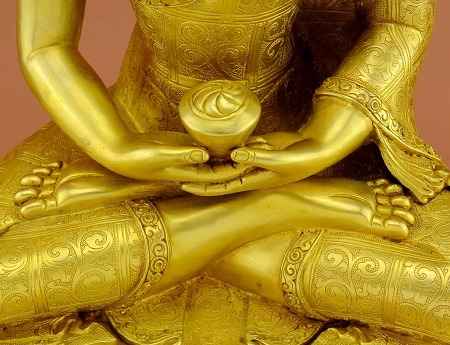
Medicine Bowl
A Medicine or “lapis” bowl is associated with a very popular Mahayana Buddhist deity called Medicine Buddha or “Bhaisajyaguru”. The medicine bowl contains the lapis nectar which will cure all suffering.
However, this nectar is again metaphorical because Buddhists believe that all suffering is the result of the defilements. As such, the special herbs depicted inside the lapis bowl will cure the inner sickness of attachment, hatred and ignorance.
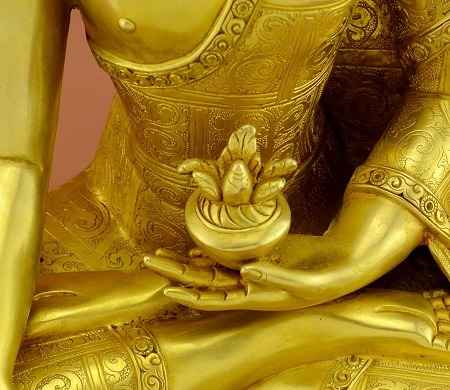
Can your Buddha statues be filled with mantras?
Yes. All of our Nepali Buddha statues come with a removable base and they are hollow inside. Therefore, they can be filled with mantras and other materials.
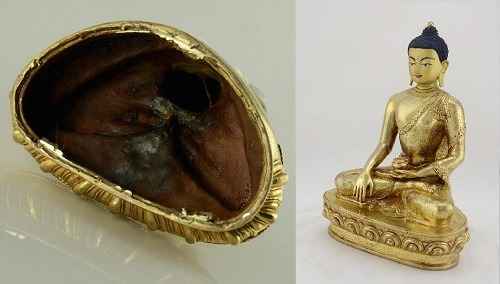
Do you cover the face of the Buddha statue?
Yes. We understand that it is important for some buyers not to see the face of the Buddha before it is blessed by their guru. If this is your preference, you need not worry because we safely wrap the face of the Buddha statue as a precaution before shipping. This is to protect the delicate gold face painting and it also serves very well as a face cover for ritual purposes.
Do you have filling and consecration services?
Yes, we work with gurus in Nepal who are specially qualified to perform the consecration and filling of our statues. The cost for the filling materials is a set price depending on the size of the statue. However, the cost of the consecration service is discretionary and it is considered a “contribution” to the monastery – not an expense. Please contact me before shipping if you wish to have us perform the filling and consecration of your Buddha statue in Nepal.
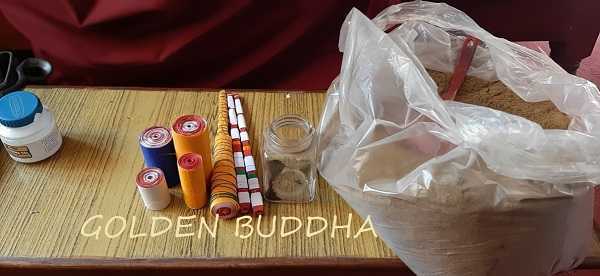
Are your Nepali items certified?
Yes, all of our Nepali Buddha statues are certified by the Department of Archaeology in Kathmandu before they are exported. Plus, all ritual items and Tibetan thangkas which are required to be certified will have the certification documents included with your purchase. Read more about government certification.
Are your statues fire gilded or electroplated?
We use both methods on our Buddha statues and ritual items. However, the vast majority of the Buddha statues are fire gilded. These statues are labeled “24k gold gilded”. If so, they were finished using the hand processed fire gold gilding method with mercury. However, if the product is listed as “gold plated” then the electroplating method was used.

